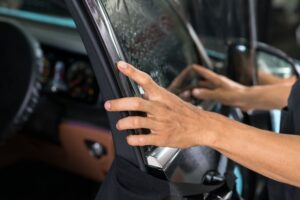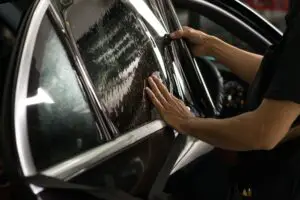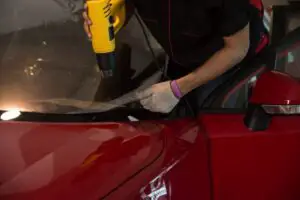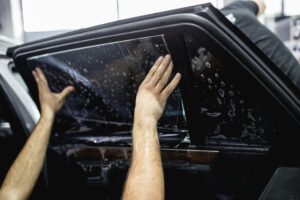Tinting laws for car windows are laws that relate to how reflective the car’s windows are and how much light they are allowed to let in.
While tinting windows may seem harmless at first, it can severely impact the performance of police officers, which is why these laws exist.
Alabama window tint laws specify that all cars must allow 32% light in from all windows, except rear and backside windows for SUVs and Vans.
All windows must not be more than 20% reflective, and car owners can have non-reflective tints on the top 6 inches of the car’s windshield.
These are the main laws about tinting windows in Alabama, and I will now go over these in-depth. So without any further delay, let’s get started with this one!
Table of Contents
- 1 How Much Tint Darkness Is Legal In Alabama?
- 2 Window Tint Reflection And Tint Colors
- 3 Medical Exemption Of Window Tint Laws In Alabama
- 4 Get A Certified Sticker From The Company
- 5 Other Window Tint Law Rules And Regulations In Alabama
- 6 Cost Of Car Window Tint In Alabama
- 7 Frequently Asked Questions
- 8 Conclusion
How Much Tint Darkness Is Legal In Alabama?

As mentioned above, the light level that goes through the windows must be according to a certain threshold.
This is measured in VLT or Visible Light Transmission level, measured in percentages.
Hence if the tint of windows needs to be above 32%, the tint must have 32 VLT.
Tint Darkness Limit For SUVs And Vans
If you drive a sports utility vehicle or a van, you are subject to the same laws as sedans but with a couple of small exemptions.
The top 6 inches of your windshield must use a non-reflective tint, and no tint must be used beyond those six inches. The front side windows must only have a minimum of 32 VLT.
The backside windows and the rear windows can use whatever darkness they want, so if you drive an SUV or a van, you will not have to worry about the tinting laws on these windows.
Tint Darkness Limit For Sedans
If you are a proud sedan owner in Alabama and want to get your windows tinted, you must have them follow the tint laws set by the state.
1. Front Windshield
Starting with the windshield, you can only have a 6 inches non-reflective tint on the top. This is to make it easier for you to drive. The rest of the windows do not have this restriction.
2. Front-Seat Side Windows
Moving on to the front seat side windows, these should have a VLT of 32 or higher. This is a trend set for other sedans windows, as I will show you.
3. Rear Window
Like the front seat side windows, the rear windows must also have at least 32 VLT. This will also make it easier for you to reverse the car.
4. Back Seat Side Windows
Finally, the back seat side windows also follow this trend and require a minimum of 32 VLT. This is usually not the case for multipurpose vehicles and only affects sedans.
Window Tint Reflection And Tint Colors
- The laws in Alabama make it that for all cars, Sedans, SUVs, and Vans, the reflectiveness must not be more than 20% reflective.
- This applies to both the front side and backside windows.
- On the subject of coloring the tint of the windows, Alabama does not restrict the color of the tinted windows. You are free to use any color you like if the tint film you use is certified.
Medical Exemption Of Window Tint Laws In Alabama

While window tint laws in Alabama are set in stone, people can have various medical exemptions when dealing with the subject.
People can request exemptions to be shielded from the sun’s rays for medical purposes.
Alabama’s Law Enforcement Agency will then issue this for the vehicle owned by the person or that he/she frequents.
These medical exemptions must be supported by a licensed registered doctor in Alabama and be in writing to get the ball rolling.
People with light-sensitive porphyria can apply this to all the windows of the vehicle, including the windshield.
Once you are granted the exemption, you will get a decal issued by Alabama’s Law Enforcement Agency which you must use on the windshield of the car you frequent or own.
This will let the authorities know that you are medically exempt from the tint laws of the car windows in Alabama.
To acquire this decal, you will, however, have to pay a small fee which goes directly into making more decals.
Get A Certified Sticker From The Company
The decal or the sticker that you will be required to place to show that you are medically exempt from the car window tinting laws will be provided by Alabama’s Law Enforcement Agency.
Apart from this, there is another sticker that you must place, which shows the compliance of the tint with the standards and regulations of Alabama.
You will get this sticker from the dealer where you got the tint and must have it applied to let the authorities know that your tint meets the standards set by the state of Alabama.
If you do not get a compliance sticker, then you may be eligible for a fine and may get pulled over.
Along with this, the film manufacturers also need to certify that the film they are distributing complies with the laws of Alabama, which is why you should buy window tints from certified distributors as well.
Other Window Tint Law Rules And Regulations In Alabama
While all the major laws have been discussed above, there are a few areas of the car windows tint laws in Alabama that must also be discussed so that you can have a better understanding of the law.
- The side mirrors have no restrictions placed on them in the state of Alabama.
- You can use tints of any color on all windows except for the windshield, which must use a transparent color tint for the first 6 inches from the top.
- Vehicles that are tinted before factory delivery or allowed under federal law are exempt from the rules.
- The tints being used must be certified, which is why u must make sure to buy from dealers who use certified film and use a certified sticker provided by your tint dealer.
- If you are medically exempt from the car window tinting laws in Alabama, you must have a sticker/decal, which must be placed between the film and glass on each tinted window.
These are all the additional laws and smaller details that you should know about when dealing with tinting laws in Alabama.
Cost Of Car Window Tint In Alabama
If you are in the market for tinted windows, then you should know which quality you want to get.
For a basic quality tint for your car windows, certified tints can start as low as $150, using classic films and encompassing the entire vehicle.
If you are looking for better quality tints, such as ceramic window tints, then this will cost more than double at $400 per vehicle.
Factors such as warranty and number of windows will also affect this price.
You can also get a DIY tint kit which is the cheapest option; however, make sure that it comes with a compliance sticker; otherwise, it may be against the rules.
Frequently Asked Questions
Q1. Is 15% Tint Legal In Alabama?
15% tints are allowed only on the upper 6 inches of the front windshield or the back and rear windows of SUVs and vans. For standard vehicles, this tint is not allowed.
Q2. Are 5% Tints Legal In Alabama?
5% tints are allowed for the backside and rear windows for multipurpose vehicles only. This includes SUVs and vans.
Q3. Is Limo Tint Legal In Alabama?
Limo tints are only allowed on multipurpose vehicles and only on the rear and backside windows. This is because they have a 5 VLT, and a 32 VLT is required.
Q4. Can I Get Pulled Over For Tint In Alabama?
You can most definitely get pulled over for tinted windows in Alabama. To avoid this, make sure to follow the rules mentioned above.
Q5. How Much Is A Tint Ticket In Alabama?
The maximum you get for a tint ticket is $100 on your first conviction. This will increase according to your number of convictions, going up to $500 or higher and even jail time.
Conclusion
Alabama tint laws are very specific in their requirements, and there is little or no room for experimentation.
You will be required to stay above 32 VLT for most vehicles and make sure that you display the required stickers needed; otherwise, you will most certainly get pulled over.
This should no longer be an issue for you as you should now know the ins and outs of Alabama’s window tint laws, any relevant information related to them, any concerns you may have with the rules, and how you can obey them to the letter and avoid getting pulled over.

I am Tahir Azam, and I have been writing amazing articles for TaxiHack for as long as I can remember. I know everything that is to know when it comes to automobiles and is always on top of industry news and developments. While I am not an expert by any means, I pride myself on knowing the ins and outs of many different problems and, of course, their solutions. The articles on our website are some of the best and well-researched content that you will find, and I spend countless hours making sure this remains to be true. This is why I ask you to take your time out and read some of my articles, especially if you find a topic that resonates with you or is something you are looking into. This way, you will find the perfect mix of information and tips on your desired topic. Learn more about Tahir.



